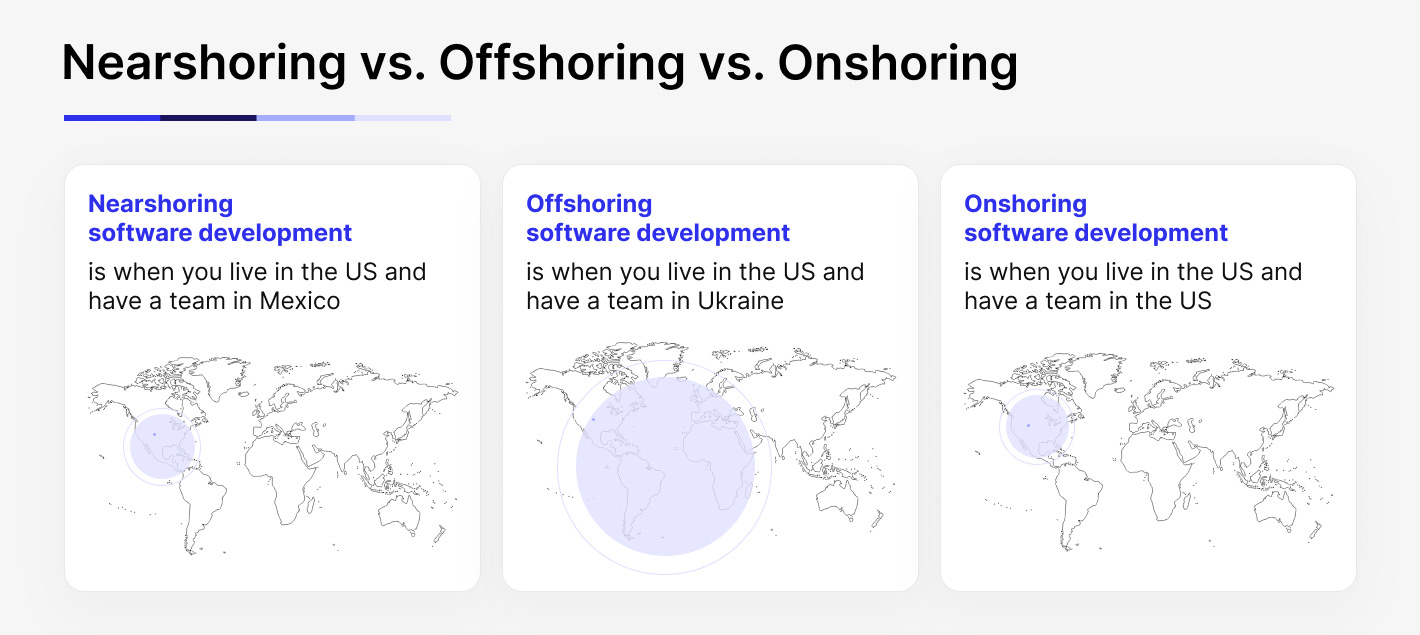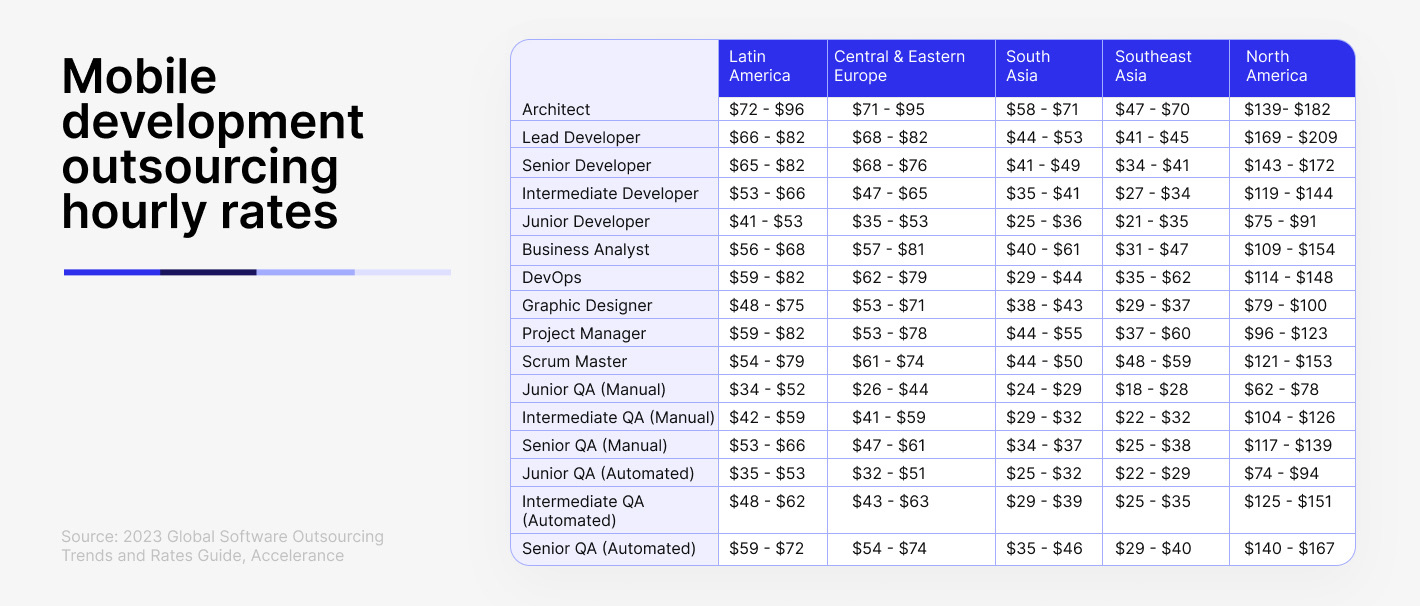High development costs, lack of hyper-specialized tech talent, suboptimal time-to-market, and lack of flexibility. These are the challenges of in-house development that you can overcome with mobile app development outsourcing.
With adoption rates at 82% and 79% in North America and Europe respectively, smartphones are an irreplaceable part of life. Consumers use it to chat, send emails, access online banking, listen to music, watch videos, and more.
Heavy smartphone use creates a fertile ground for the mobile application market, with iOS and Android mobile app revenue projected to rise to over $613 billion by 2025. The app development market is also projected to almost quadruple, from $208.5 billion in 2022 to $777.4 billion by 2032.
But if you consider developing a mobile app, be it to convert more customers, outdo competitors, or expand into new markets, the price question may be particularly daunting. An acute tech talent shortage raised development rates by 23% in 2022 in North America.

Looking elsewhere to outsource app development can reduce costs by 40-70%.
As a software development company, we at Sombra have helped multiple clients reap the benefits of outsourcing. Here’s our app development guide on outsourcing benefits, risks to consider, costs, and how to choose the right partner for outsourcing software development.
6 benefits of mobile app development outsourcing
Before we dive into the pros and cons of outsourcing, let’s break down three types of outsourcing: onshore, nearshore, and offshore.



Nearshoring vs offshoring vs onshoring
- Onshore outsourcing means hiring a service vendor within your country: e.g., a Boston company choosing app outsourcing in Los Angeles.
- Nearshore outsourcing means turning to a development company within three time zones from yours: e.g., a US company hiring a partner in Colombia.
- Offshore outsourcing means hiring a partner in a country three or more time zones away: e.g., a US-based company choosing app development outsourcing in India.
Outsourcing is especially relevant in 2023. For one, the COVID-19 lockdowns proved to companies that remote collaboration can be as efficient – but less expensive – as in-office. Plus, economic uncertainty means companies have to right-size their costs to build operational resilience.
App development costs can be 40% to 70% lower with outsourcing, according to Accelerance. But besides optimizing costs, outsourcing app development is also a way to gain access to top app developers in particular technologies, mobile app types, and industry solutions.
Reduced development costs
Outsourcing mobile app development allows you to hire mobile application developers to create a mobile app at a lower cost than that of in-house development. For one, you don’t have to factor in:
- Employee benefits and taxes
- Recruitment costs
- Office space and equipment costs for the internal team
At the same time, app development services in regions like Eastern Europe are more cost-effective due to the lower cost of living. For example, the development cost for a mobile app in the United States could easily exceed $600,000. Mobile app development outsourcing can reduce your costs by 40% to 70%.
Access to a larger talent pool
Hiring in-house developers means you can choose only from the talent pool available in your proximity. That’s why finding the right talent (and at the right price) is a top internal challenge for 50% of Deloitte’s 2022 Global Outsourcing Survey respondents.
Mobile application development outsourcing, on the other hand, allows you to go global in your search for the right mobile development expertise. What’s more, when you outsource mobile app development, you can select the best of the breed experts in the niche, from fintech to DevOps.
Plus, you can gain access to this expertise at a lower price if you outsource development beyond your country. Software outsourcing companies in Ukraine charge $25-49 per hour, while those in the US come with an average hourly rate of $100-149.
Hyper-specialized tech skills
Besides cost-efficiency, outsourcing app development benefits also include a wider variety of expertise, allowing you to adopt cutting-edge technologies. (The tech talent shortage is a barrier to adoption for 64% of emerging technologies.)
App development outsourcing allows you to quickly hire a mobile app developer with the desired skill set. For example, if you need extra team members specializing in fintech app development, fintech development agencies like Sombra are at your service.
With staff augmentation services, you can also expand your in-house team with the required talent faster than it would take to train your employees or make a new hire.
Accelerated time-to-market
App development in-house takes more time than application development outsourcing if you don’t have an in-house team unburdened by other tasks or projects. Recruitment is both labor-intensive and time-consuming: the average time-to-fill for a tech role is 56 days in the US and Canada.
Of course, outsourcing mobile app development also requires some time and effort to pick the right outsourcing development company. That said, a mobile app outsourcing company already has a pool of talented mobile app outsource developers ready to tackle your project. So, once you hire development services, the project will get kicked off immediately.
So, development outsourcing allows you to start development within weeks, not months. On top of that, a good outsourcing partner has automation practices and project accelerators to streamline development and speed up time-to-market.
Flexibility
Just like you can’t hire in-house developers within one to two weeks, you also can’t lay them off as fast. This makes for a lag between a change in business needs and a change in the composition of the app development team.
Outsourcing mobile application development, in turn, allows you to quickly scale development teams up and down whenever needed. This ability to right-size your team promptly is one of the most significant outsourcing development benefits as it also maximizes cost-efficiency.
An app development agency that you outsource application development has an internal talent pool that it can dip into whenever you need additional expertise. For example, if you decide to venture into web application development outsourcing, a development agency like Sombra can provide you with a selection of candidates within days.
You’re also free to switch between multiple outsourced application development engagement models depending on your custom app development needs.
Control over the outsourcing team
When you outsource mobile application development, you can choose to hire a dedicated development team or opt for staff augmentation. Both those engagement models put you in charge of managing the outsource team.
This means you have full oversight over the software development project. Your project manager will be responsible for the day-to-day management of the app development process.
This final item among the benefits of mobile app outsourcing allows you to minimize miscommunication and mismanagement risks. It also allows you to ensure perfect project alignment with your business goals when you outsource app development for mobile apps.
Looking for a reliable outsourcing partner for your custom mobile app? Contact us to discuss your needs and hire a team with an in-house level of involvement and dedication to your success.
5 risks of outsourced app development
While mobile application development outsourcing does save time and money, it also comes with certain risks. When you outsource apps, you may have to overcome time zone, communication, and culture gap challenges. You also have to trust your application outsourcing partner with sensitive data.
So, before you hire a development service, make sure you protect your interests against these five risks.
Time zone differences
If you opt for offshore app development, you may have to adapt to a significant time zone difference. For example, a US-based company that chooses application development outsourcing in India will have to manage a nine-hour time difference.
This time lag can turn meetings, project management, and communication into a significant challenge. Different time zones can also slow down resolving critical issues or fulfilling tasks that require the client’s approval.
Sombra’s advice. Prioritize outsourcing mobile application development to nearshore development partners to minimize the communication lag. Before you hire an app development partner, discuss how the team handles the time zone difference.
Cultural differences
Outsourcing mobile application development to a different country can mean dealing with cultural gaps during the development process. For example, opting for app development in India can prove to be difficult if your partner is a yes-man unwilling to contradict you.
Sombra’s advice:
- When you outsource mobile app development, look for software development companies already working with clients from your region. Prioritize outsourcing development to countries with a similar culture, e.g. Ukraine and Latin America for clients from the US.
- Before outsourcing application development, discuss how the app development business avoids a mismatch in expectations, decision-making styles, and conflict resolution.
Security issues
Outsourcing mobile app development means entrusting a third party with your intellectual property and access to sensitive data. This entails a variety of app development risks, from security breaches affecting your business (case in point: Kaseya ransomware attack) to intellectual property theft.
Sombra’s advice:
- To minimize risks during mobile application development outsourcing, discuss security practices the software development agency follows during a project. Outsource mobile application development to companies with SOC2 or ISO27001 certifications.
- Sign a non-disclosure agreement and add security provisions to the contract before kicking off the app development partnership.
Poor technical documentation
Sometimes, mobile app development outsourcing can result in you receiving a great product that turns out to be unmaintainable due to a lack of proper documentation. Without it, you won’t be able to easily make changes to your mobile app, and your quality assurance team won’t be able to test it properly.
Sombra’s advice. Discuss with your development partner how it handles documentation. When outsourcing apps, you should expect developers to extensively comment on the code, provide sources for borrowed snippets, and explain certain problem-solving decisions.
Insufficient business analysis
You may think you know what you need when you outsource mobile development, but you may not have the technical expertise to understand whether those requirements are sound. That’s why your development outsourcing company may have to step in and suggest how to execute your vision more efficiently.
For that to happen, however, your outsourcing partner has to gain a deep understanding of your business before they develop an app for you. They have to have a full grasp of your target audience, competitor mobile applications, and your organization’s goals and constraints.
Sombra’s advice: Before you outsource app development, discuss the discovery phase of application development outsourcing with your potential partner. It should include conducting market research, identifying the scope of development work, and pinpointing possible roadblocks.
How much does it cost to outsource mobile application development?
The exact outsourcing app development cost depends on the project’s specifics, such as:
- Application’s complexity
- Product type (native iOS/Android vs cross-platform app)
- App development service vendor’s location and rates
- Technology costs (proprietary tools, APIs, etc.)
To roughly estimate how much it costs to outsource your mobile app project, you can use the following formula:



Application development cost
App development cost = developer’s hourly rate * team size * project duration
Albeit it doesn’t take into account all mobile app outsourcing cost factors, it’ll give you an idea of the price range for your project.
Let’s say it should take 16 weeks and five outsourcing developers to develop a mobile app in your case. You outsource app development offshore to a company in Colombia, where the rates are $25-49 per hour. Your mobile app development outsourcing cost estimate would then be $80,000-$156,800.



2023 Global software outsourcing rates
But if you hire a company for the same software development outsourcing project in the United States, where the rates are $100-149 per hour, the estimated cost of outsourcing app development shoots up to $320,000-$476,800.
Here’s an overview of mobile development outsourcing hourly rates depending on the vendor’s location and the specialist type:



App development outsourcing rates
Outsourcing apps for Android and iOS comes with a slightly different hourly rate, too. For example, according to Upwork, freelance developers typically charge $45-75 per hour to develop mobile apps for iOS. Outsourcing mobile development for Android, in turn, entails an hourly rate of $35-60.
Choosing native Android and iOS app development over cross-platform software development will double your expenses. Each of the native apps has to be built from scratch, which effectively doubles project duration. Cross-platform mobile app development, in turn, means the two apps share most of the codebase.
How to choose the right outsourcing app development company for your project
Outsourcing mobile development to the wrong service provider can result in missed deadlines, subpar software and documentation quality, and security incidents, among others. Here’s how to outsource app development to a reliable application outsourcing partner:
- Pinpoint the expertise you’re after. Are you planning to outsource iPhone app development or need an Android app development outsourcing partner?
- Search for experts in your niche. If you want to outsource a fintech app development project, look for outsourcing companies specializing in fintech in particular. Check out the candidates’ case studies and look for app development projects similar to your app idea.
- Consider the company’s reputation. Check out the company’s profile on Clutch (here’s ours, for example). You can also reach out to previous clients to discuss their experiences.
- Consider internal project management capabilities. If you don’t plan to oversee the team in-house, discuss how the vendor’s project managers work with clients. The company should provide regular updates and be transparent about performance metrics.
- Discuss the post-launch collaboration. Custom software development and deployment are only the beginning. If you plan to outsource application maintenance, ensure your service vendor is ready for a long-term applications outsourcing partnership.
How Sombra meets client needs: A case study
Since 2015, we’ve been collaborating with a global top 15 bank, helping it swiftly adjust development capacities to evolving business needs. Here’s how we ensure we meet and exceed expectations during this outsourced software development project:
- Joint planning sessions. We meet with our client every quarter to ensure our services align with business needs and plan our collaboration for the next quarter.
- Onsite trips. Our engineers visit the client’s headquarters every year, and our project managers go on the same trip twice a year. This allows us to be deeply immersed in our client’s business.
- Full involvement. Our team pulled 70-80 hour weeks when the client was in peak season. We also underwent the SOC2 security audit for our client.
Looking for a reliable partner to outsource mobile development to? Contact us to hire a development team tailored to your needs – and dedicated to your success.
6 steps to outsource app development with Sombra
Ready to reduce costs while gaining access to a larger talent pool with application development outsourcing? Here’s how to outsource app development in six specific app development steps, from pinpointing app project requirements to selecting the right outsourced development pricing model.
Step 1. Identify the project requirements and the budget
The first step in mobile development outsourcing is fleshing out the details of the development project you plan to outsource:
- Resources needed. Will you outsource development as a whole or expand your in-house capabilities with additional app outsourcing resources?
- Goals. Why do you want to build an app? What do you want to achieve with it?
- Product type. Will you outsource iOS app development or Android app development? Or do you want to outsource web app development?
- Target audience. Who will be using your mobile app?
- Functionality. What features should your app have?
- Range of outsourcing services. Will you need UI/UX design services? Will you take on post-launch support in-house or outsource app support? Or will you need to outsource code writing only?
- Budget. How much are you willing to dedicate to outsourcing costs?
Step 2. Pick the right outsourcing company
Sifting through app development companies to find “the one” will take some time. Here’s a short step-by-step guide for finding the right mobile app development outsourcing partner:
- Create the initial company pool. Asking for references is usually the more efficient way to do it than browsing lists of top app development companies. For example, our new clients come to us following a reference from our previous clients.
- Make a shortlist. Use basic criteria like location (e.g. removing India-based companies if you prefer to avoid outsourcing app development to India) or services provided (e.g., whether they have UI/UX designers).
- Check technical and industry expertise. Browse case studies to see if the company worked on application development outsourcing projects similar to yours. Check out their Clutch and LinkedIn profiles to gauge their reputation.
- Kick off the pre-sales process. Contact the shortlisted companies and take note of how they handle potential clients seeking to outsource app development.
Step 3. Get the initial selection of mobile app developers
In most cases, you can select who will be working on your project when you outsource app development. Here’s how it works at Sombra:
- We as the app development company assess your project and choose the most suitable tech stack. For example, if you outsource iPhone app development, we’ll help you hire mobile app developers specializing in Kotlin.
- We set up the roles and determine which of our outsourced app developers could fit them well in your outsourced team, creating a candidate pool.
- Our project manager screens the app developer candidates for the soft and hard skills it takes to build your iOS app or Android app.
- We present the candidate selection to you, along with all CVs. Since you’re the one outsourcing app development, you can interview them and you have the final say in selecting the team developers.
- To benefit from team scalability as one of the advantages of outsourcing, our clients can ask for reducing or expanding the team size whenever necessary.
Step 4. Evaluate developers’ expertise and experience
Here’s how to select the best talent among the candidate pool the outsource development company presents you with:
- Review the candidates’ CVs and portfolios. While CVs give you a general idea of the experience of each outsourcing developer, the portfolio shows the extent of their coding skills in action.
- Conduct a technical interview. If you can’t evaluate whether the outsourced developer is up for app development work yourself, have someone with the technical background conduct interviews. Make sure your questions are relevant.
- Consider sample coding tests or live coding. To see the developer’s skills in action before outsourcing mobile app development, ask them to solve a simple problem with code – or watch them code live.
Even though interviews are optional in our process, we advise our clients not to skip out on interviewing potential mobile developers during mobile application outsourcing. This is a great opportunity to see for yourself whether the outsource app developers have the relevant experience and skills for developing your app.
Step 5. Select an appropriate engagement model
When you outsource mobile app development, you can choose from three outsourcing model types:
- Staff augmentation: seamlessly adding an outsource developer to your in-house app development team.
- Dedicated team (also known as managed team): hiring a whole software development team as an outsource development service, complete with a project manager and a QA engineer.
- Traditional outsourcing: the development and project management are the vendor’s responsibility, while you’re in charge of business requirements.
Staff augmentation application outsourcing services are a good choice for you if:
- You already have an in-house team.
- You need to close a talent gap fast for a specific short-term project.
A managed team is a better application development outsourcing model if:
- You have an in-house team but can’t reassign it to a new project.
- You want to hire a development firm to outsource apps or an MVP without losing focus on core business activities.
Traditional custom software development services are a suitable choice if:
- You have a clear timeframe, budget, and project requirements for the outsourced development company.
- You don’t have an in-house team and can’t afford to hire one for developing mobile apps.
Step 6. Choose the right pricing model
There are two main pricing models you can choose for mobile app development outsourcing:
- Time and materials. This application software outsourcing pricing model means paying the software outsourcing company for the hours of work dedicated to your project.
- Fixed price. Under this model, you pay the development company a fixed price for the whole project.
The time and materials model is suitable for outsourcing application development projects that:
- Entail a long-term partnership
- Don’t have a clear scope of work
- Are prone to changes in scope and timeline
The fixed price model is recommended for outsourcing software projects that:
- Are simple (e.g., outsourced web development) and small to medium in size
- Have a clearly defined scope that isn’t prone to change
- Have a predictable timeline
Looking for a dedicated managed team that goes the extra mile for you? Contact us to discuss your needs – and we’ll turn your idea into a mobile app your users will love.
Final thoughts
It’s up to you to weigh in on outsourcing pros and cons and decide whether to outsource mobile development.
That said, the benefits of outsourcing outweigh those of developing an app in-house. The risks can be mitigated with the right policies and workflows adopted by the mobile app agency.
That’s why choosing the right partner is crucial in outsourcing mobile app development. The same goes for planning to outsource web application development or outsourcing software development in general.
Sombra can be a good match for you. Let us show you how – contact us to discuss your app idea and needs and kick off the discovery phase for your project.











